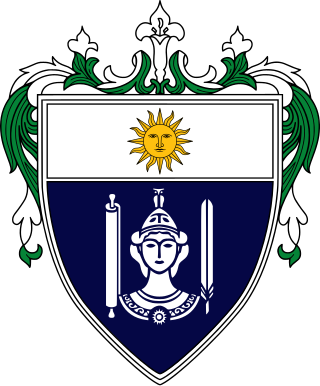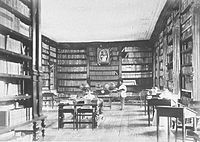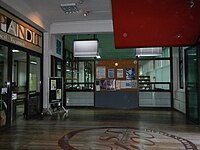Baybayin is a Philippine script. The script is an abugida belonging to the family of the Brahmic scripts. Geographically, it was widely used in Luzon and other parts of the Philippines prior to and during the 16th and 17th centuries before being replaced by the Latin alphabet during the period of Spanish colonization. It was used in the Tagalog language and, to a lesser extent, Kapampangan-speaking areas; its use spread to the Ilocanos in the early 17th century. In the 19th and 20th centuries, baybayin survived and evolved into multiple forms—the Tagbanwa script of Palawan, and the Hanuno'o and Buhid scripts of Mindoro—and was used to create the constructed modern Kulitan script of the Kapampangan and the Ibalnan script of the Palawan people. Under the Unicode Standard and ISO 15924, the script is encoded as the Tagalog block.

The University of Santo Tomas, officially the Pontifical and Royal University of Santo Tomas, Manila or colloquially as USTè, is a private, Catholic research university in Manila, Philippines. Founded on April 28, 1611, by Spanish friar Miguel de Benavides, third Archbishop of Manila, it has the oldest extant university charter in Asia and is one of the world's largest Catholic universities in terms of enrollment found on one campus. It is the main campus of the University of Santo Tomas System that is run by the Order of Preachers.

Bienvenido L. Lumbera was a Filipino poet, critic and dramatist. Lumbera is known for his nationalist writing and for his leading role in the Filipinization movement in Philippine literature in the 1960s, which resulted in his being one of the many writers and academics jailed during Ferdinand Marcos' Martial Law regime. He received the Ramon Magsaysay Award for Journalism, Literature and Creative Communications in 1993, and was proclaimed a National Artist of the Philippines for literature in 2006. As an academic, he is recognized for his key role in elevating the field of study which would become known as Philippine Studies.

The National Library of the Philippines is the Philippines' official repository of information on cultural heritage and other literary resources. It is located in the district of Ermita in Manila, near historically significant offices and institutions such as the Museum of Philippine Political History and the National Historical Commission. As with these entities, it is under the jurisdiction of the National Commission for Culture and the Arts (NCCA).

The Arch of the Centuries is a triumphal arch at the Plaza Intramuros of the University of Santo Tomas in Manila, Philippines. Half of the current structure, the side facing the UST Main Building is the ruins of the 17th-century arch door of the first UST campus in Intramuros, while the side that faces España Boulevard is a replica inaugurated in 1954.

The University of Santo Tomas Faculty of Arts and Letters, popularly known as "UST Artlets" or "UST AB", is the liberal arts school of the University of Santo Tomas, the oldest and the largest Catholic university in Manila, Philippines.

The University of Santo Tomas Faculty of Medicine and Surgery (USTFMS) is the medical school of the University of Santo Tomas, the oldest and largest Catholic university in Manila, Philippines.

The University of Santo Tomas is one of the oldest existing universities and holds the oldest extant university charter in the Philippines and in Asia. It was founded on April 28, 1611, by the third Archbishop of Manila, Miguel de Benavides, together with Domingo de Nieva and Bernardo de Santa Catalina. It was originally conceived as a school to prepare young men for the priesthood. Located Intramuros, it was first called Colegio de Nuestra Señora del Santísimo Rosario and later renamed Colegio de Santo Tomás in memory of Dominican theologian Saint Thomas Aquinas. In 1624, the colegio was authorized to confer academic degrees in theology, philosophy, and arts. On November 20, 1645, after representations by Vittorio Riccio, Pope Innocent X elevated the college to the rank of a university and in 1680 it was placed under royal patronage.
The Pontifical and Royal University of Santo Tomas (UST) Quadricentennial Celebration took place from December 18, 2009 to January 27, 2012. The agenda before the quadricentennial year in 2011 included the introduction of new academic programs, improvements in the university's infrastructure, and other projects to raise UST's national and international prominence and promote its role as a social catalyst.

During the Spanish colonial period in the Philippines (1521–1898), the different cultures of the archipelago experienced a gradual unification from a variety of native Asian and Islamic customs and traditions, including animist religious practices, to what is known today as Filipino culture, a unique hybrid of Southeast Asian and Western culture, namely Spanish, including the Spanish language and the Catholic faith.
The Official Gazette, which is printed by the National Printing Office (NPO), is the public journal and main publication of the government of the Philippines. Its website only uploads what has been published; it is managed by Presidential Communications Office (PCO).
This is a timeline of the history of the Pontifical and Royal University of Santo Tomas, the oldest university in Asia, comprising important events of the history of the university and of the development of Philippine higher education in general. To read about the background to these events, see History of the University of Santo Tomas. See also the history of the Rector Magnificus of the University of Santo Tomas, and the Santo Tomas Internment Camp

The Archives of the University of Santo Tomas (AUST), also known in Spanish as the Archivo de la Universidad de Santo Tomas, is located at the Miguel de Benavides Library in Manila. The AUST is the central repository of historical and rare documents pertaining to, but not exclusively, to the history of the University of Santo Tomas, one of the oldest existing universities in Asia, and the oldest institution of higher learning in the Philippines. The collections consist of historical documents such as Papal bulls, royal decrees, rare Filipiniana prints, historical treatises, addresses, sermons, novenas, catechisms in many Philippine languages, national periodicals, and academic records of all educational institutions in the Philippines during the Spanish period. The archives is also home to the only incunabula, or books printed before 1500, in the country.

The Sentro Rizal is a Philippine government-sponsored organization whose main objective is the global promotion of Filipino art, culture, and language. Established by virtue of the National Cultural Heritage Act of 2009, its headquarters is located at the National Commission for Culture and the Arts (NCCA) office in Intramuros, Manila. Sentro Rizal aims to promote Philippine arts, culture, and language throughout the world through the establishment of Philippine centers in various countries which initiate and organize cultural training programs and activities for overseas Filipinos.

The University of Santo Tomas Baybayin Documents or UST Baybayin Documents are two 17th century land deeds written in Baybayin script.

The Benavides Monument is a memorial in the University of Santo Tomas in Manila, Philippines built to commemorate the founder of the University of Santo Tomas, Miguel de Benavides. Located in the Plaza Benavides in front of the UST Main Building, the monument consists of a bronze statue of Benavides rising on top of a granite pedestal. The present monument was unveiled in 1946.
The Thomasian Welcome Walk (TWW) is an annual event of the University of Santo Tomas in Manila, Philippines. Freshmen walk through the Arch of the Centuries, a monument that served as the original doorway to the first campus of the university in Intramuros.

The Plaza Benavides, also known as Benavides Park or Benavides Garden in Manila, Philippines is a landscaped park located in the University of Santo Tomas. It contains the Benavides Monument, built to commemorate the founder of the university, Miguel de Benavides.
















